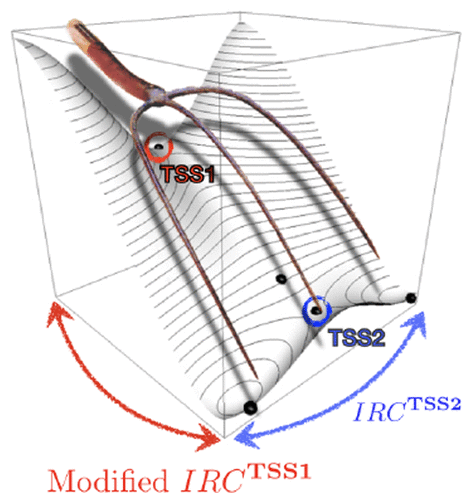当前位置:
X-MOL 学术
›
J. Chem. Theory Comput.
›
论文详情
Our official English website, www.x-mol.net, welcomes your feedback! (Note: you will need to create a separate account there.)
Construction of Two-Dimensional Potential Energy Surfaces of Reactions with Post-Transition-State Bifurcations.
Journal of Chemical Theory and Computation ( IF 5.5 ) Pub Date : 2020-05-29 , DOI: 10.1021/acs.jctc.0c00172 Hsiao-Han Chuang,Dean J Tantillo,Chao-Ping Hsu
Journal of Chemical Theory and Computation ( IF 5.5 ) Pub Date : 2020-05-29 , DOI: 10.1021/acs.jctc.0c00172 Hsiao-Han Chuang,Dean J Tantillo,Chao-Ping Hsu

|
Reactions with post-transition-state bifurcations (PTSBs) involve initial ambimodal transition-state structures followed by an unstable region leading to two possible products. PTSBs are seen in many organic, organometallic, and biosynthetic reactions, but analyzing the origins of selectivity for these reactions is challenging, in large part due to the complex nature of the potential energy surfaces involved, which precludes analyses based on single intrinsic reaction coordinate (IRC; steepest-descent path in mass-weighted coordinate). While selectivity can be predicted using molecular dynamics simulation, connecting results from such calculations to the topography of potential energy surfaces is difficult. In the present work, a method for generating two-dimensional potential energy surfaces for PTSBs is described. The first dimension starts with the IRC for the first transition-state structure, followed by a modified reaction coordinate that reaches the second transition-state structure, which interconverts the two products of a bifurcating reaction path. The IRC for the second transition-state structure constitutes the second dimension. In addition, a method for mapping trajectories from Born–Oppenheimer molecular dynamics simulations onto these surfaces is described. Both approaches are illustrated with representative examples from the field of organic chemistry. The 2D-PESs for five asymmetric cases tested have clear tilted topography after the first transition-state structure, and the tilted direction correlates well with the selectivity observed from previous dynamic simulation. Instead of selecting reaction coordinates by chemical intuition, our method provides a general means to construct two-dimensional potential energy surfaces for reactions with post-transition-state bifurcations.
中文翻译:

具有过渡后状态分叉的反应的二维势能面的构造。
与过渡后态分叉(PTSB)的反应涉及初始的双峰过渡态结构,然后是不稳定区域,导致两种可能的产物。在许多有机,有机金属和生物合成反应中都可以看到PTSB,但是分析这些反应的选择性的起源具有挑战性,这在很大程度上是由于所涉及的势能面的复杂性,因此无法基于单一内在反应坐标进行分析( IRC;质量加权坐标中的最速下降路径)。虽然可以使用分子动力学模拟来预测选择性,但是很难将此类计算的结果与势能表面的形貌联系起来。在本工作中,描述了一种为PTSB生成二维势能面的方法。第一个维度从第一个过渡态结构的IRC开始,然后是到达第二过渡态结构的修改后的反应坐标,该坐标转换了分叉反应路径的两个乘积。用于第二过渡状态结构的IRC构成第二维。此外,还描述了一种将来自Born–Oppenheimer分子动力学模拟的轨迹映射到这些表面上的方法。两种方法均以有机化学领域的代表性实例说明。测试的五个不对称情况下的2D-PES在第一个过渡态结构之后具有清晰的倾斜形貌,并且倾斜方向与从先前动态模拟中观察到的选择性密切相关。而不是通过化学直觉选择反应坐标,
更新日期:2020-07-14
中文翻译:

具有过渡后状态分叉的反应的二维势能面的构造。
与过渡后态分叉(PTSB)的反应涉及初始的双峰过渡态结构,然后是不稳定区域,导致两种可能的产物。在许多有机,有机金属和生物合成反应中都可以看到PTSB,但是分析这些反应的选择性的起源具有挑战性,这在很大程度上是由于所涉及的势能面的复杂性,因此无法基于单一内在反应坐标进行分析( IRC;质量加权坐标中的最速下降路径)。虽然可以使用分子动力学模拟来预测选择性,但是很难将此类计算的结果与势能表面的形貌联系起来。在本工作中,描述了一种为PTSB生成二维势能面的方法。第一个维度从第一个过渡态结构的IRC开始,然后是到达第二过渡态结构的修改后的反应坐标,该坐标转换了分叉反应路径的两个乘积。用于第二过渡状态结构的IRC构成第二维。此外,还描述了一种将来自Born–Oppenheimer分子动力学模拟的轨迹映射到这些表面上的方法。两种方法均以有机化学领域的代表性实例说明。测试的五个不对称情况下的2D-PES在第一个过渡态结构之后具有清晰的倾斜形貌,并且倾斜方向与从先前动态模拟中观察到的选择性密切相关。而不是通过化学直觉选择反应坐标,



























 京公网安备 11010802027423号
京公网安备 11010802027423号